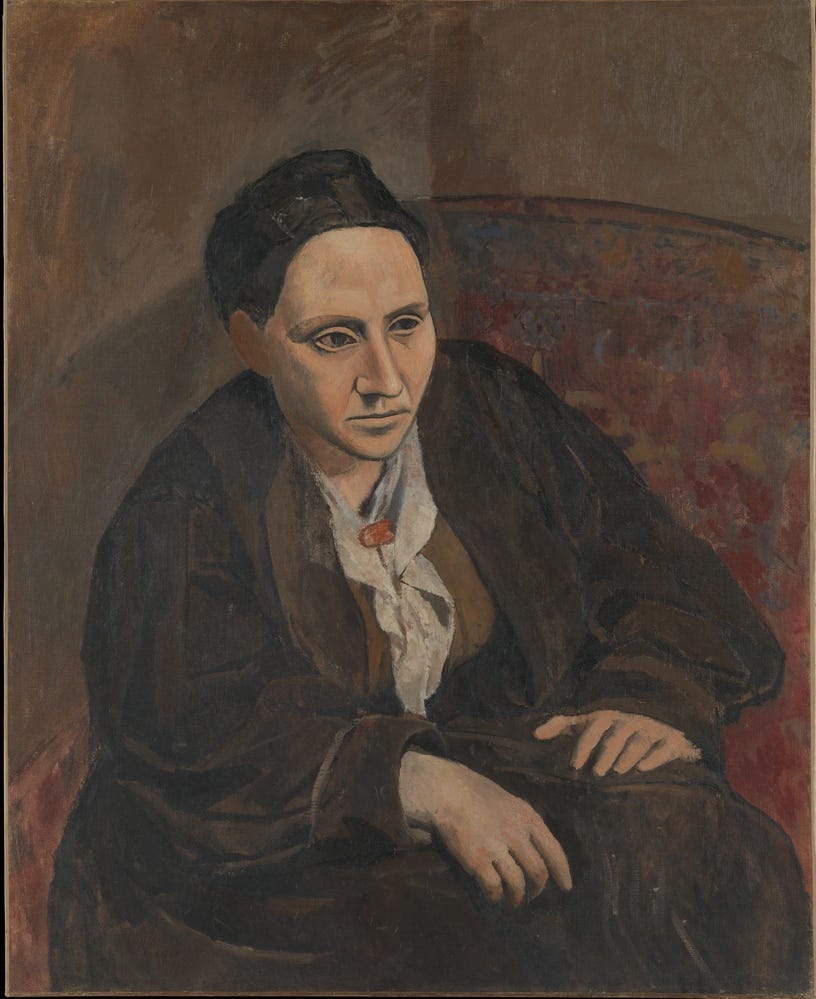'The Actor' - Pablo Picasso: A Singular Role in a Tumultuous Career
A rags-to-riches story which could have ended tragically.
Pablo Picasso (1881-1973) is an iconic artist, needing no introduction. For those new to art history, Picasso is often associated with the phrase, “My five-year-old could have done that!” - but of course, they didn’t. Picasso, like Rome, wasn’t built in a day, and his career went through several distinct phases
‘The Actor’ is a striking example of his evolution. Painted at the beginning of his Rose Period, still under the influence of his preceding Blue Period, this artwork has been on a roller-coaster journey that mirrors many of the challenges art faced throughout the 20th century.
Genesis
Paris, 1904. Picasso had just met Fernande Olivier, a bohemian artist who would become his partner for the next seven years. From 1901 to 1904, Picasso's Blue Period was defined by somber, melancholic works, heavy with themes of poverty and despair, all rendered in grim blue tones. Now, energized by his tumultuous relationship with Fernande, he began exploring themes of harlequins and acrobats, and his palette shifted to warmer shades of pinks, oranges, and reds - marking the start of his Rose Period.
Yet, times were tough for Picasso and his lover, and canvases were expensive. Unable to afford new ones, he painted ‘The Actor’ (196 x 115 cm) on the reverse of an already used canvas by another artist.
In ‘The Actor’, Picasso was developing what would later become his signature style, with form taking precedence over realism. This piece marks a transition between the Blue and Rose Periods: the subject reflects his newfound fascination with the theatrical world, while the elongated figure and the figure's unusual hand position still echo the mannerism of his Blue Period.
From 1905 onward, Picasso's financial situation improved, largely due to the patronage of Gertrude Stein, a key art collector. Her support enabled his first commercial successes.
‘The Actor’ soon found its way into the collection of Picasso’s friend, Frank Burty Haviland, an early collector of Cubist art.
Ownership Changes
Cologne, 1912. ‘The Actor’ was displayed publicly for the first time at the landmark Sonderbund exhibition, which introduced German audiences to Impressionism and its successors. This was made possible by Alice and Paul Friedrich Leffmann, a German Jewish couple who had purchased the painting earlier that year.
As conditions for Jews worsened under the Nazi regime, the Leffmanns sold the painting to dealers Paul Rosenberg and Hugo Perls in 1938 for $13,200 (equivalent to $295,000 today). The sale helped finance their escape to Brazil to escape the deadly repression.
In 1941, the painting was acquired by the Chrysler heiress through the Knoedler Gallery in New York. It was later donated to the MET in 1952, where it has remained on display ever since - but not without incidents.
The Painful Rip
Metropolitan Museum of Art (New York), January 22nd, 2010. A young woman, art student, carefully observed the master's painting and, perhaps drawn in by the actor's performance, fell with her head against the canvas, tearing 15 centimeters in the lower right-hand corner!
The student, devastated, burst into tears and explained to the guards who came running “I don’t know what happened, I’m so sorry!”. She could, as this painting, one of the largest of the Rose Period, is estimated between $100 and $130 million.
As stated by the museum, “the damage did not occur in a focal point of the composition” and the restoration team perfectly repaired the vertical tear. This included a 6-week period where the paint was placed painted-side down under various weights to mitigate the damage.
The painting was back on display by April 2010 as part of the exhibition “Picasso in the Metropolitan Museum of Art,” this time safely behind plexiglass…
The Trial
New York, 2016. Laurel Zuckerman, the great-grand-niece and heir of the Leffmanns, sued the MET, seeking to reclaim ownership of ‘The Actor’. She argued that the painting had been sold under duress during the Nazi era, in yet another claim related to the restitution of art taken during World War II. Of course, the painting’s value had skyrocketed since its sale in 1938.
Two years later, a federal judge ruled that the MET could retain ownership. The ruling was based on evidence that the Leffmanns had negotiated with multiple private parties and sought to maximize the value of the sale, even if the circumstances surrounding the sale were tragic.
Conclusion
Despite its tumultuous history, ‘The Actor’ remains on display at the MET. Its journey reflects many of the key trends in 20th-century art. First, the transition from realism to abstraction, as seen in the stylized, elongated figure of the actor, set against an abstract background.
Secondly, the painting's history underscores the commodification of art and the pursuit of ever-increasing value by the ultra-wealthy. While no transactions have disrupted ‘The Actor’ since World War II, the exponential rise in Picasso's market value has certainly fueled legal disputes over ownership.
Additionally, Zuckerman's case highlights the moral and legal complexities surrounding art looted or sold under duress during the Nazi era. Many museums now face similar questions about the provenance of their collections, particularly regarding works acquired during periods of colonial expansion.
Finally, the accidental damage to ‘The Actor’ points to broader concerns about the conservation and protection of artworks. In an era when activists increasingly target cultural treasures for protest, many of which have no direct connection to the causes they advocate, the need for careful preservation is more pressing than ever.
I think it is simply remarkable to think that a painting that almost never existed - due to lack of resources - could now be at the center of so much history and debate.







